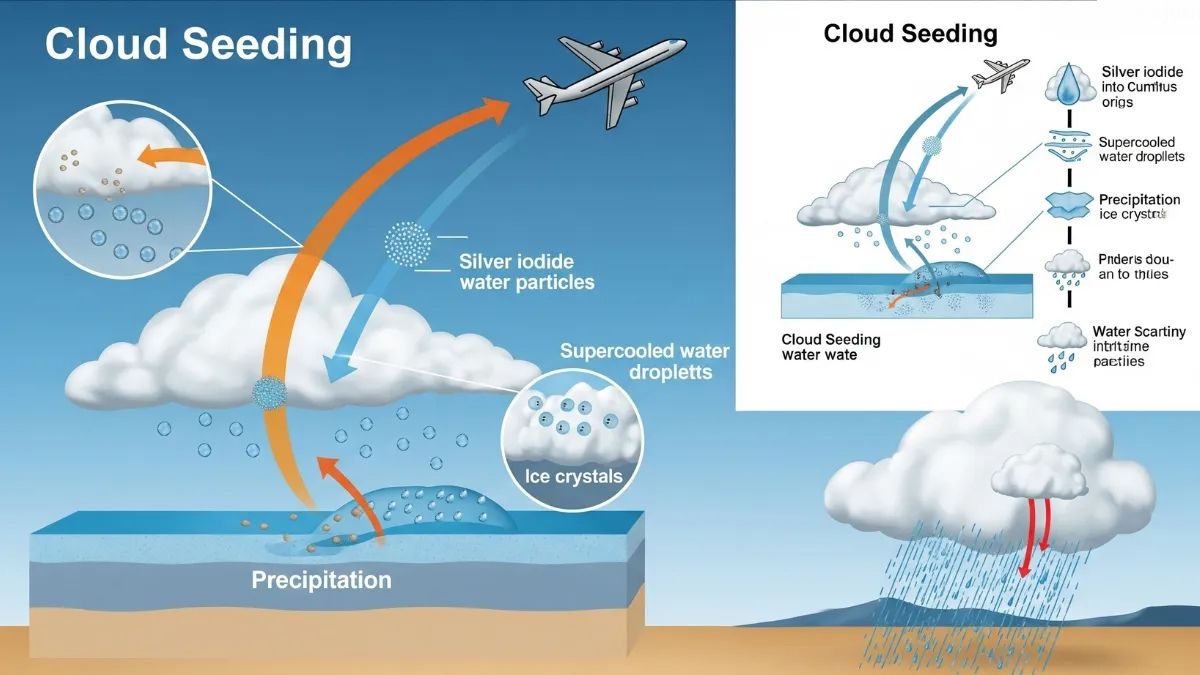Context:
The National Capital Delhi, which faces the serious problem of air pollution every year, is now going to take an innovative step to deal with this crisis. The first artificial rain trial was planned in Delhi between July 4 and 11, 2025, but was postponed due to monsoon and will now be conducted between August 30 and September 10. The project is being led by the Indian Institute of Technology (IIT) Kanpur and aims to reduce pollution through cloud seeding technology.
What is Cloud Seeding?
Cloud seeding is a scientific process in which specific substances like silver iodide, salt, or dry ice are introduced into clouds to promote condensation of water vapor, leading to rainfall or snowfall. These particles act as "nuclei" that attract water vapor. When the vapor accumulates around these nuclei, it condenses into larger droplets which eventually fall to the ground as precipitation.
There are two main types of cloud seeding:
1. Cold Cloud Seeding: Silver iodide is used in supercooled clouds (below 0°C) to form ice crystals.
2. Warm Cloud Seeding: Salt particles help merge smaller water droplets into larger rain droplets.

Highlights of the Delhi Project:
- This initiative is titled “Technology Demonstration and Evaluation of Cloud Seeding as an Alternative for Delhi NCR Pollution Mitigation.” The project involves the use of a specially modified Cessna aircraft, which will disperse a seeding mixture using flare-based systems.
- The seeding mixture, developed by IIT Kanpur, includes silver iodide nanoparticles, iodised salt, and rock salt. This composition accelerates droplet formation in moisture-rich clouds, thereby generating artificial rain. The goal is to wash out airborne dust, smoke, and other pollutants, helping to purify the city’s atmosphere.
Effectiveness and Global Experience:
The effectiveness of cloud seeding depends heavily on weather conditions, particularly the presence of suitable moisture-laden or supercooled clouds. Global experience shows that it can increase precipitation by an average of 5–15%.
In countries like the USA and Australia, cloud seeding has been successfully used to enhance snowfall and water supply. Countries like the UAE and China have also employed it for improving air quality and mitigating drought. In India, a past pilot project showed only a 3% increase in rainfall.
However, concerns remain regarding the environmental impact of chemicals like silver iodide. Although the World Health Organization (WHO) considers small amounts of silver iodide to be safe, further studies are needed to assess its long-term effects. Additionally, the cost and scalability of this technology, particularly in a densely populated city like Delhi, pose significant challenges.
Conclusion:
This artificial rain experiment in Delhi represents a scientific and experimental approach to tackling urban air pollution in India. Its success will largely depend on favorable weather conditions, but if proven effective, it could serve as a model solution for other polluted cities across the country. As a fusion of technological innovation and environmental consciousness, this method offers a promising path forward in the fight against air pollution.






